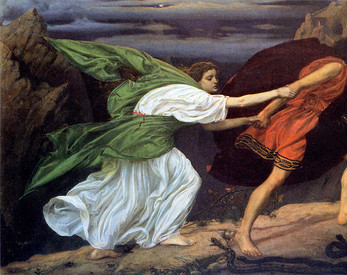Escape
Escape was based on my obsession with Hadestown, as I thought it would be interesting to have an investigative playthrough of "running away from hell". This, summed with my obsession for Pelgrane Press, which produces primarily mystery games (such as King in Yellow and Trail of Cthulu), gave Escape its initial concept.
My goal was to communicate with my player that change is possible through small and incremental changes, but that the support of a community, people who understand what you are experiencing in some level, makes it much easier— and perhaps joyful. To express this, I used the mechanics of a routine. Going to work, trying to quit, and trying to escape are all possible ways of escaping, but using Eurydice's advice and pursuing Orpheus' tip make it much easier.
This argument is also reflected in the win-condition, though in a lesser way— depending on whether the player chooses to help or not help Eurydice, they get a different ending. The idea was to reward the player who looks back, against the recommendation of the original myth, with a positive message for their prosocial behaviour.
This game interacts with Grag Costiakyan's definition of a game in many instances; the presence of the self-evident (albeit directed) goal to escape and a struggle in pursuing this goal— players can interact with the world in a more or less careful manner, and this results in Hades/the Devil coming and erasing their memory of the tunnels, and resetting their perception of him. The narrative and the game structure are intertwined.
When I began writing Escape, I meant to use the Key Nodes structure, as well as the timer mechanic from Queers in Love at the End of the World. The first, as it's one that I'm very familiar with, as it's normal in mystery games I run in my home roleplaying game sessions— it gives itself very well to investigative games. The second, for its cleverness and how it gives stakes to actions. I ended up dropping the second for limitations on how to apply it to a limited segment of the game and for my lack of knowledge on Javascript.
As the game progressed, I had to modify the structure to accommodate my thematic arguments, and ended up borrowing the structure of map-based games such as Zork I (which I played for a couple of hours after reading Nat Mesnard's article), and mixing both structures gave the final product.
I playtested with the same crew from my cycle game: my wife, my brother-in-law (who's in the class) and a friend (who is almost my ideal player). I asked them to speak their minds as they played the game, and in the end, prompted general feedback. My wife's feedback was the most impactful, as it was in the earlier development stages of the game. Initially, I had the idea of omitting the underline that prompts players to move in the story (a function native to Twine); the idea was to incentivize exploration of all passages, but my wife was immediately confused by it, as she had already played other Twine games. The confusion did not aid in the investigative tone I had intended and interrupted her experience of other parts of the game, so I abandoned it. My brother-in-law's feedback ensured me that I was on the right track, and my ideal player confirmed that the playthrough was in the direction I had envisioned when making it.
| Published | 28 days ago |
| Status | In development |
| Platforms | HTML5 |
| Author | I am Eurydice |
| Made with | Twine |
| Tags | Twine |

Leave a comment
Log in with itch.io to leave a comment.